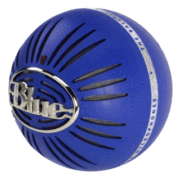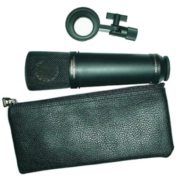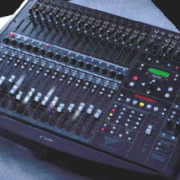PLEASE NOTE: This article has been archived. It first appeared on ProRec.com in October 1999, contributed by then Contributing Editor Ted Perlman. We will not be making any updates to the article. Please visit the home page for our latest content. Thank you!
This past summer I had the immense pleasure of working with the legendary band “Chicago”. I was hired to engineer, co-produce, and record the live portion of an album scheduled to be released in the middle of October, 1999. Since the last live album they recorded was over 30 years ago (“Chicago Live at Carnegie Hall”), the guys felt that it was a good time to let the public hear the current configuration of the band, which still has half of it’s original members. All of the horn section is original (Jimmy Pankow on trombone, Lee Loughnane on trumpet, and Walt Parazaider on woodwinds), as is Robert Lamm on keyboards and vocals. The legendary Bill Champlin (“Sons Of Champlin”) has been with the band around 15 years on keys, guitar, and vocals. Rounding out the band is one of the greatest drummers on the planet – Tris Imboden; Keith Howland, a great guitarist and the female fans’ favorite; and Jason Scheff on killer electric bass and high Peter Cetera-type vocals. (His dad played bass for Elvis Presley).
They are truly a great group of guys to work with. I suppose that after 30-something platinum albums and just as many years of touring, you would expect these guys to simply go through the motions and play the old hits, but nothing could be further from the truth. Every show I recorded was treated as if it was their last show – I never heard anybody perform at anything less than stellar levels.
These guys really rock – the first thing you realize about “Chicago” is that they are a “rock band with horns”, not some elevator music, easy listening kind of group. The shows are loud, with plenty of serious solos and playing. As with most modern touring extravaganza groups, “Chicago” has refined the on stage monitoring to a highly controlled system, where each member has a custom fitted pair of stereo earpieces in which they each receive a custom mix of the music. (at least eight separate mixes are going on during EACH song!) Standing in the wings, all one can hear are the cymbals and drums being hit, but nothing else – no bass, guitar, anything! But take a walk out into the house, and BAM! The music is slammin’! This kind of control made my job much easier, with the amount of leakage cut down to a bare minimum. It was however, impossible to talk to any of them while their earpieces were in. (“LEE!! CAN YOU HEAR ME, LEE!!!????)
After extensive meetings with some of the band, road manager Steve Brumbach, equipment designer and sound specialist Roger Gibbons of “A-1” Audio, and my fellow engineer/co-producer, Ed Thacker (I did the first group of shows, and Ed did the last half), it was decided to go with the Tascam DA-98 as the recording medium. I was insistent on NOT using any computers or hard disk systems because, well, we only had one shot at getting the shows down. Hard disk errors were not a problem I wanted to add to the equation, and all agreed with me.
The board would be a fabulous Amek 58 input “Recall”, which actually would only be used to monitor the tape returns. All of the signals would go directly to brand new Klark Teknik mic preamps and from there to the DA-98’s. Then the signal would be routed back to the board for CD, DAT, and cassette reference mixes and listening sessions. We had a bunch of classic dbx compressor/limiters (165’s and 160’s), which were patched into the mic pre’s using the insert jacks. This method, combined with Roger’s great cabling setup, allowed for the cleanest signal possible to go to tape.
“Chicago” has a LOT of instruments and mics onstage, which meant there would be a lot of tracks. And a lot of machines (10 DA-98’s). The show runs about 2 hours. We were using 60 minute tape, which, allowing for any extra talking and audience interaction, meant that the tapes would have to be changed at least twice during the show. I’m talking 30 tapes per show. You should have seen myself and Roger ejecting and inserting the various tapes, while the band “talked” to the crowd. I always let loose a sigh of relief when the machines all locked, went into record, and the band got the cue to start the next song.
Anybody who’s attended my classes at UCLA, read my columns at ProRec, or worked with me in the studio knows my total belief in equipment that lets you get the job done and does not require pampering and babying. I like to get the music on tape as quick and easily as possible.
The DA-98’s, while an industry standard, do NOT adhere to this philosophy. Where someone might be able to get an ADAT recorder, and record something immediately without reading the manual, when it comes to the TASCAM’s you’re going to have to do your homework. Pages and pages of menus, proprietary machine id #’s, methods of formatting, and other features require hours of learning. Likewise for the RC 848 remote controller.
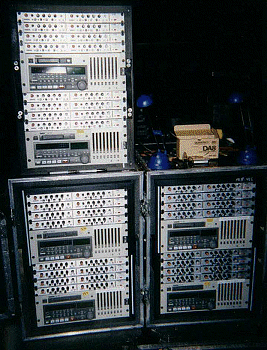
We went into the Klark-Teknik mic pre’s and directly to the tape machines.
You should have seen us ejecting and re-inserting all of those tape cartridges in less than 30 seconds.
So, even though I have had considerable experience using the DA-series machines, I decided to take a few of them along with the remote unit back to my studio for a few days. My assistant Paul Fox and myself spent a few days endlessly trying to crash the machines and blow them up, so as to be prepared what to do in case something would happen in concert. This is a good practice to get into for everybody who records – spend time learning how to get out of problems that might arise. That way, when the client is in the studio or the audience in their seats, you’ll be prepared. I often sit in my studio at night, staring at all my equipment, imagining what I would do if this and that broke. My wife thinks I’m a little nuts when I do this. I must look like a zombie, but it helps to be prepared.
This practice came in very handy when, at the first show – Grant Park in Chicago, during the first song I glanced down at the remote control. All of the lights were on, and the display had a series of “Y”‘s running across all the rows. The remote had crashed! The band was playing, the crowd was jammin’, and I was facing the possibility that nothing was getting recorded. But then I remembered that the first DA-98 would automatically become the “Master” if the remote stopped for any reason. Which is what happened. I used DA98#1 as the master for the rest of the show, and not a beat of the show was missed. It pays to read the manual. But I must add, I have never heard of an Alesis BRC crashing. So much for Tascam’s legend of invincibility versus the ADAT system. However, regardless of what anyone says, BOTH systems work and sound great. (If I had used ADATs for the recording, everything would have turned out fabulous, too.)
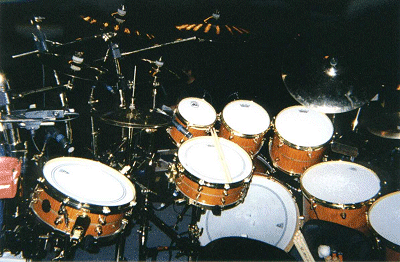
Notice the Shure SM57’s on both snares.
No matter what mics are available, most engineers will always use this for snares and guitar amps.
One of the things that you learn from being on the road for a thousand years (it often feels like I have toured for that long) is that musicians never play sound checks at anywhere near the volume they play the show at. As an engineer, you must keep this fact in mind, especially if you’re planning on recording the show. You must allow a little leeway in your levels, so that the first song is not a digital distortion extravaganza. This was an extra problem, since the first show we were recording was a huge outdoor festival show at Grant Park, which meant NO sound check. “Great”, I thought. “How do I set my levels?” The techs who did line checks for me played at nowhere the level that the band did. I thanked my years of experience and set the levels at where I guessed the band play at. Except for a few minor tweaks, my levels remained the same throughout all the subsequent shows on the tour. Whew!
Recording a band onstage can be a fullfilling experience, where you feel you and the band are connected together in an almost spiritual way. That is, if you can SEE the musicians and they can SEE you. Our first show in Chicago, I was right at the foot of the stage, slightly stage left, bouncing and rocking through the whole show as I pushed groups of faders up and down. Jimmy Pankow told me in the hotel room after the show that it made him feel good to see me so “into” the show. He made me feel good, too, seeing him blowing bursts of notes out of his trombone, standing legs apart like some heavy metal guitarist.
However, once we got to Caesar’s Palace in Atlantic City, there wasn’t any room at the side or front of the stage to put my mixing console. So, back behind the curtains I went. Although I had 2 video monitors so I could see the band and who was changing mics, etc, it just wasn’t as much fun. Watching the band on TV ain’t as cool as seeing them 10 feet in front of you. It made me think of all the “invisible” musicians touring today. You didn’t think all that music you hear from the speakers is coming from those 4 guys visible onstage, did you?
One potential source of problems was that band planned to do overdubs after each show. The horns wanted to double or fix parts from the previous night’s show. The method of patching that we had was not really designed with that in mind. I had hoped that the only daytime recording would be new songs that weren’t in the show, which would simply use the same recording method as the nightime shows. Piece of cake. But overdubbing horns meant that the signal that was sent directly to each machine had to be re-routed to the machine being used for overdubs.
My advice? Don’t overdub on your live recording setup. Go into a studio and do it there. Much easier. But we did get it done. Although, since my remote had not worked from that first show, and no one seemed to be able to get a replacement, I had to cue and record using the first machine. That’s a decent work-around for the shows, but a terrible method for punching in and out. The punches all had a gap on punching out. I think it was because of using the first machine as a master. I sure wish I had that remote… Or a BRC and some ADATs……..
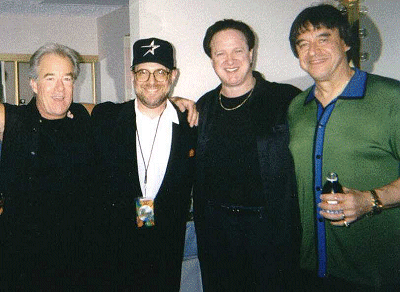
The whole band would gather nightly after each show to listen to the performances. This required a mastery of mixing on my part above and beyond any session I have ever done. As the tapes played, each member of the band took turns stepping up to the board to turn up the volume of his particular instrument. By the time half of the show had gone by, all of the levels were exactly as I had started with, just equally louder. That’s one of the reasons why producers don’t like to let the whole band attend mix sessions. For my last show, I simply made a DAT tape and played that, so nobody could make any individual adjustments. That worked best, and everybody just listened to the overall perfomances. Much more efficient.
As it turned out, the first show from Grant Park was the best performance of the shows we recorded. The band played like they were kids again, plus it was in Chicago, their hometown, it was a fabulous sunny day, the audience was great, and everything just went perfect from the downbeat. VH-1 even brought up a young sax player from the inner city, who actually sat in with the band on a song. Great memories for her forever! That show would become the “framework” for the CD, with certain portions of songs from other performances mixed in.
We got a great audience sound as well, due to the 4 Neumann U87’s and 2 Sennheiser 416 shotguns. The Neumann’s were placed on the left and right, in the center and at the back of the audience. The 416’s were placed on either side of the stage and pointed at the crowd. “Chicago’s” manager Peter Schivarelli had told me “please, all we really need to get from this show is the audience noise, since this is the biggest crowd we’re going to have”. We captured not only the crowd, but what turned out to be the best show of the tour.
It is a well known fact that water and rain are NOT good things to let enter your equipment. During one of the band’s songs, “Let It Snow”, snow flakes are dropped from above. These are not real snow, but they are made of real water. I draped myself over everything I could cover as it fell, screaming “no, it’s going to ruin all the tapes!” at the top of my lungs. Luckily, nothing got ruined. But I did notice at the tour-ending show in Los Angeles that they had started covering equipment onstage with plastic sheets during that song. I guess I wasn’t being paranoid, after all.
Being with this band on the road was one of the greatest experiences I have ever had. Plus, their songs are ALL great. Two hours of nothing but major hits! And I didn’t even have to buy a ticket. Next time “Chicago” comes to your town, make sure you go to the show. Whether you’re 12 years old and a Backstreet Boys fan, 25 and a Korn freak, or 60 and a Frank Sinatra afficianado, you’ll go away feeling totally entertained. When the “Chicago 26” CD comes out, buy it. I was there. The shows were great!
Key Sound Personnel for “Chicago”
Tony Blanc
House sound engineer. Veteran of mixing everybody, from Sting to David Bowie. He does an excellent mix, night after night. Very classy English fellow.
Ken Parkin
Monitor mixing engineer. I still don’t know how he keeps track of all of those mixes.
Hank Steiger
Guitar technician. He makes sure all of those guitars and basses are in tune and in performance-ready mode. And believe me, there are an awful lot of guitars and basses…
Russ Achzet
Keyboard technician. You think it’s hard keeping track of all your patches? Try it for a bunch of keyboards, night after night after night….
Tony Leo
Horn technician. “Where’s my reeds?” “What happened to my favorite mouthpiece?”“What do you mean, there’s no slide in the case?” Ask Tony….
Mike Bessinger
Drum technician. And Tris has a LOT of drums. And he really plays ALL of them during the show, especially during his drum solo, which was never the same from show to show.
Steve Brumbach
Tour Manager. I include him here because without him, nothing gets done. The band doesn’t get to the gig, everybody sleeps in the street, nobody eats or gets per diem, etc… No Steve – no “Chicago” shows. I owe him mucho thanks for helping me get around. He made me feel welcome from the first day to the last.
“Chicago” Record Input Patch
| Description | Mic |
| Kick Resonator | D112 |
| Kick 91 | SM91 |
| Kick 52 | SM52 |
| Snare Top | SM57 |
| Snare Bottom | SM57 |
| Snare Trigger | DIRECT |
| Piccolo Snare / Cowbell | SM57 |
| Hi-Hat | 451 |
| Rack Tom #1 | SM98 |
| Rack Tom #2 | SM98 |
| Floor Tom #1 | SM98 |
| Floor Tom #2 | SM98 |
| Ride | 451 |
| Overhead Stage R | 414 |
| Overhead Stage L | 414 |
| Bass | DIRECT |
| Keith Guitar L | SM57 |
| Keith Guitar R | SM57 |
| Keith Acoustic | DI |
| Robert Acoustic | DIRECT |
| Bill Vocal | Beta87 |
| Robert Vocal | AT |
| Keith Vocal | Beta87 |
| Jason #2 Vocal | AT |
| Jason Center Vocal | AT |
| Horn Vocal #1 | Beta58 |
| Horn Vocal #2 | Beta58 |
| Trombone | R/F SM98 |
| Saxophone | R/F SM98 |
| Trumpet | R/F SM98 |
| Percussion | SM57 |
| Bill Keys L | DIRECT |
| Bill Keys R | DIRECT |
| Bill Leslie Low | 421 |
| Bill Leslie High L | SM57 |
| Bill Leslie High R | SM57 |
| Robert Keys L | DIRECT |
| Robert Keys R | DIRECT |
| Robert Leslie | 421 |
| Bill Guitar | SM57 |
| Samples #1 | DIRECT |
| Samples #2 | DIRECT |
| Samples #3 | DIRECT |
| Samples #4 | DIRECT |
| Click | DIRECT |
| Audience #1 | Senn 416 |
| Audience #2 | Senn 416 |
| Audience #3 | U87 |
| Audience #4 | U87 |
| Audience #5 | U87 |
| Audience #6 | U87 |
(Special thanks to Phil Cody for scanning and editing the pictures accompanying this article)
